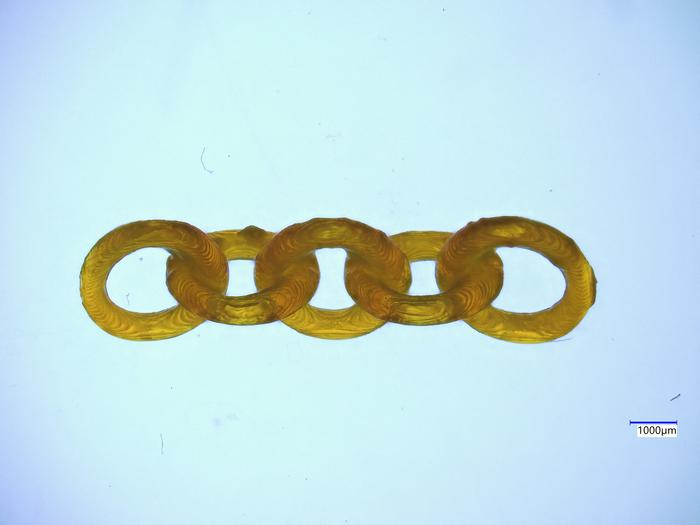In the ever-evolving landscape of additive manufacturing, a groundbreaking advancement promises to revolutionize the way complex 3D structures are fabricated. Researchers have developed an innovative vat polymerization technique that utilizes a novel resin capable of simultaneously forming permanent solid objects and dissolvable support materials in a single printing process. This cutting-edge method heralds the advent of one-pot 3D printing, marking a significant leap toward faster, more efficient, and intricately detailed manufacturing.
Traditional vat photopolymerization, renowned for its rapid curing and high resolution, relies on photoreactive liquid resins that solidify upon exposure to specific wavelengths of light. However, creating intricate objects with complex interlocking components or overhangs has long confronted a critical bottleneck: the necessity for temporary support structures. Conventionally, these supports require a multi-step fabrication process involving immersing the partially printed object in a separate resin batch to build the supports, followed by meticulous manual removal, which is both time-consuming and resource-intensive. Addressing these challenges, the new one-pot approach integrates dual-curing chemistry within a single resin formulation, enabling simultaneous printing of permanent and sacrificial components.
At the heart of this innovation lies a carefully engineered resin blend combining acrylate/methacrylate monomers with epoxy-based monomers, each uniquely responsive to distinct wavelengths of light. The resin incorporates photoreactive compounds designed to absorb both ultraviolet (UV) and visible light, triggering orthogonal polymerization pathways. Upon exposure to visible light, acrylate monomers polymerize to form dissolvable support materials characterized by anhydride linkages, which can later be selectively degraded without damaging the primary structure. Conversely, when subjected to UV light, the epoxy components cure to form robust, permanent thermoset networks constituting the main architecture of the printed object.
This dual-wavelength curing strategy was realized through the development of a bespoke 3D printer capable of emitting synchronized UV and visible light patterns. Leveraging this optical system, the research team successfully printed elaborate multipart objects — such as interlocking chains, complex checkerboard patterns, and nested spheres — where permanent structures and supports were effected simultaneously within the same resin vat. This breakthrough not only simplifies the printing process but also substantially reduces material waste and post-processing time.
A pivotal feature of the sacrificial supports lies in their chemical composition. The anhydride-based scaffolds formed under visible light polymerization exhibit selective degradability in mild base solutions, such as sodium hydroxide at ambient temperature. Immersing the printed assembly in this solution dissolves the support structures completely within approximately fifteen minutes, unveiling the permanent object without residue or compromise to its mechanical integrity. Importantly, degradation products are nontoxic, aligning with environmentally conscious manufacturing principles and expanding potential biomedical applications.
The implications for tissue engineering and biofabrication are particularly exciting. The capacity to print embedded, articulated components such as hinges or interlocking joints in a single print cycle could transform scaffold design, enabling more physiologically relevant constructs with dynamic functionality. Moreover, the rapid removal of supports enhances fidelity and structural accuracy, which are critical for producing customized implants and regenerative templates.
Maxim Shusteff, a corresponding author of the study, remarked on the significance of this chemical innovation. He highlighted that the method effectively circumvents one of the most tedious aspects of vat polymerization — the manual extraction of delicate supports — through elegant photochemical design rather than mechanical complexity. This simplification could democratize access to high-resolution 3D printing, fostering new avenues across materials science, biomedical engineering, and advanced manufacturing sectors.
Technically, the researchers meticulously optimized the resin formulation to balance the kinetics of dual polymerizations and prevent cross-reactivity that could blur the distinction between permanent and sacrificial domains. The epoxy network formation under UV light is orthogonal to the acrylate curing under visible light, ensuring discrete patterning. Additionally, tuning the wavelength selectivity of photoinitiators was crucial to achieve precise spatial control. This level of chemical sophistication underscores the importance of advanced photopolymer chemistry in pushing additive manufacturing beyond current limitations.
Demonstrating the robustness of their approach, the team produced sequentially complex geometries that would be challenging or impossible to fabricate with conventional methods. For example, printed interlocking rings and balls encapsulated within cages were crafted seamlessly, showcasing the technique’s capability for creating moving parts embedded within static frameworks. Such functional assemblies are paramount for miniaturized mechanical devices, soft robotics, and haptic systems, where embedded freedom of motion must be preserved.
Beyond biomedical and engineering applications, this methodology has potential in rapid prototyping for electronics, where supports can be dissolved without harmful residues that might interfere with device function. It also holds promise for sustainable manufacturing paradigms by minimizing excess material use and simplifying recycling processes. The environmentally benign dissolution pathway aligns with growing calls for green chemistry in industry.
The researchers acknowledge that further work is needed to expand the palette of available monomers and photoinitiators to tailor mechanical properties, cure speeds, and degradation profiles. Scaling the approach to larger build volumes and integrating multi-material prints with this dual-wavelength curing paradigm represent natural next steps. Nevertheless, this pioneering study sets a foundational platform for next-generation 3D printing technologies that marry chemical ingenuity with engineering precision.
In summary, this new dual-wavelength vat polymerization technique represents a transformative step toward efficient, one-pot embedded 3D printing. By harnessing advanced photochemistry to seamlessly integrate permanent structures with dissolvable supports, the method removes longstanding barriers in fabrication complexity, print time, and post-processing labor. As the technology matures, it is poised to impact diverse sectors ranging from regenerative medicine to micro-mechanics, driving forward the frontiers of additive manufacturing.
Subject of Research: Advanced 3D printing via dual-wavelength vat polymerization for simultaneous fabrication of permanent and sacrificial materials.
Article Title: “Dual-Wavelength Simultaneous Patterning of Degradable Thermoset Supports for One-Pot Embedded 3D Printing”
News Publication Date: 4-June-2025
References: DOI: 10.1021/acscentsci.5c00337
Image Credits: Adapted from ACS Central Science 2025, DOI: 10.1021/acscentsci.5c00337
Keywords
Chemistry, Materials Science, Additive Manufacturing, Photopolymerization, 3D Printing, Dual-Wavelength Curing, Sacrificial Supports, Thermoset Polymers, Tissue Engineering




